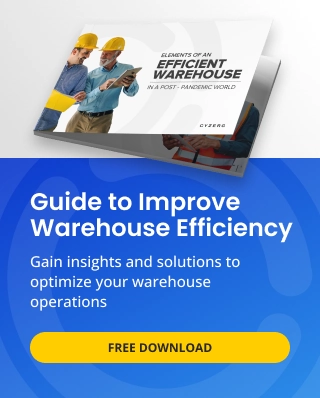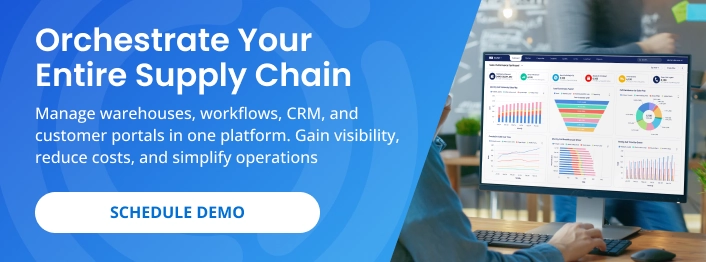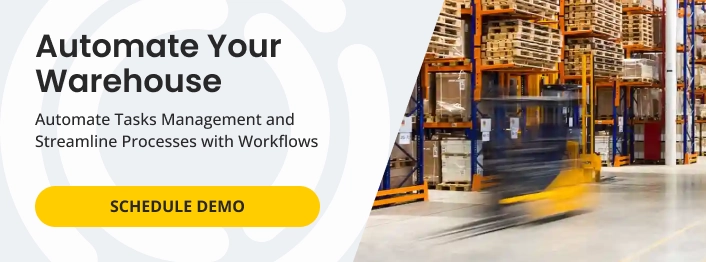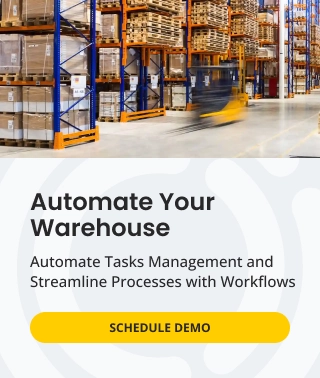In today’s fast-moving markets, supply chain integration is no longer optional—it’s essential. Businesses depend on smooth coordination between warehouses, transportation, suppliers, and customers to stay competitive. Yet, many companies still operate with disconnected systems, leading to delays, errors, and higher costs.
Supply chain integration solves this by connecting processes, data, and technology into a single, unified flow. When systems “talk” to each other, companies gain real-time visibility, streamline operations, and deliver a better customer experience. Research shows that organizations with integrated supply chains are more resilient and achieve higher efficiency compared to those relying on siloed tools.
Modern SaaS platforms are making integration easier and more affordable than traditional ERP systems. By unifying modules such as warehouse management, workflows, and customer portals, companies can achieve the benefits of integration without heavy IT investment.
This guide will explore what supply chain integration is, its benefits, challenges, best practices, and how SaaS solutions are shaping the future.
What Is Supply Chain Integration?
Supply chain integration is the process of connecting people, processes, and technology across the entire supply chain to work as a single, coordinated system. Instead of each department or partner operating in isolation, integration ensures that data flows seamlessly between warehouses, transportation, suppliers, and customers.
There are two main forms of integration:
- Internal integration connects functions within a company, such as inventory management, sales, and operations.
- External integration extends this connectivity to suppliers, logistics providers, and customers for greater collaboration and visibility.
Without integration, businesses often struggle with data silos, duplicated work, and poor decision-making. By contrast, integrated supply chains create efficiency, reduce costs, and improve customer satisfaction.
Modern SaaS platforms make this possible by bringing different modules into one ecosystem. For example, Supply Chain Orchestrator unifies warehouse management, workflows, customer portals, and CRM. This not only streamlines operations but also ensures that sales and customer service teams share the same real-time data as warehouse staff—improving collaboration, strengthening customer relationships, and reducing errors across the supply chain.
Types of Logistics Integration
Supply chain integration can take different forms depending on how processes and technologies are connected. The most common types include:
Data Integration
This focuses on ensuring accurate, real-time data across the supply chain. For example, a WMS updates stock levels instantly, while a Dimensioner captures weight and measurements to eliminate manual errors. When integrated with a CRM, sales and customer service teams gain the same visibility as warehouse staff, reducing mistakes and improving customer communication.
Process Integration
Here, the goal is to align workflows between departments and partners. Automated Warehouse Workflows ensure tasks move smoothly across teams, while the WMS Mobile App enables employees to execute those tasks directly on the floor—improving speed and accountability.
Technology Integration
This involves using platforms and applications that connect stakeholders across the supply chain. A Customer Portal allows clients to track orders and access documents in real time, while APIs connect the system with transportation providers or other third-party tools. Together, these technologies eliminate silos and create a unified supply chain ecosystem.
By combining data, processes, and technology into a single flow, businesses can achieve true supply chain integration—improving accuracy, speed, and customer satisfaction.
Key Benefits of an Integrated Supply Chain
Investing in supply chain integration delivers measurable improvements across operations, customer service, and profitability. By connecting data, processes, and technology, businesses eliminate inefficiencies and unlock new opportunities for growth.
Real-Time Visibility
When systems are disconnected, managers often make decisions with incomplete or outdated information. Integrated tools such as a Warehouse Management System (WMS), WMS Mobile Apps, and Dimensioner provide accurate, up-to-date data on inventory levels, dimensions, and cargo status. With this visibility, companies can reduce stockouts, optimize space, and respond quickly to changes in demand.
Lower Operational Costs
Manual processes, duplicated work, and miscommunication create hidden costs. Automating tasks with Warehouse Workflows reduces errors and labor waste, while the WMS Mobile App allows employees to complete tasks directly on the floor—eliminating delays and paper-based processes. Over time, these improvements translate into significant savings.
Faster Order Fulfillment
An integrated supply chain connects every step, from order entry to shipping. For example, a Customer Portal provides real-time updates for clients, while the WMS and workflows ensure orders move seamlessly through the warehouse. This level of coordination shortens cycle times and improves delivery accuracy.
Stronger Collaboration and Customer Satisfaction
Integration isn’t just about efficiency—it also improves relationships. A Supply Chain CRM ensures that sales, customer service, and warehouse teams share the same data. Customers receive accurate updates, faster responses, and more reliable service, which builds trust and loyalty.
Improved Decision-Making
With all data flowing into a single platform, managers can analyze trends, identify bottlenecks, and make proactive decisions. Research shows that companies with integrated supply chains achieve 20% higher efficiency and 15% lower costs compared to those with siloed systems.
Together, these benefits highlight why integration is no longer optional—it’s a competitive necessity. By combining WMS, workflows, mobile tools, customer portals, dimensioning, and CRM in one platform, businesses can build a connected, efficient, and customer-focused supply chain.
Best Practices for Supply Chain Connectivity
Building a connected supply chain requires more than technology. It also takes strategy and disciplined execution. The following best practices help businesses create an environment where data flows freely, processes run smoothly, and collaboration becomes second nature.
Standardize Data and Processes
Discrepancies in data often lead to costly mistakes. Standardizing how inventory, orders, and shipments are recorded ensures consistency across the supply chain. For example, the Dimensioner automates the capture of dimensions, weight, and images. At the same time, the WMS centralizes this information for accuracy and easy access.
Automate Workflows
Manual processes slow operations and increase errors. By using Warehouse Workflows, companies can define tasks, triggers, and notifications that keep operations moving automatically. As a result, efficiency improves and staff can focus on higher-value activities.
Enable Real-Time Execution
A connected supply chain depends on timely updates. With the WMS Mobile App, warehouse staff can process tasks directly on the floor, update cargo statuses, and capture cargo details immediately. Consequently, decisions are always based on the latest data.
Strengthen Collaboration Across Stakeholders
Collaboration between internal teams, suppliers, and customers is vital. A Customer Portal allows clients to track orders, access documentation, and communicate with your team. Meanwhile, a Supply Chain CRM connects sales and customer service with operations. This alignment ensures everyone works from the same information.
Adopt a Scalable SaaS Platform
Traditional ERP systems are costly and rigid. Modern SaaS solutions like Supply Chain Orchestrator provide flexibility through modular tools—WMS, workflows, mobile app, supply chain portal, dimensioning, and CRM. Moreover, these modules can scale as the business grows. This reduces upfront costs and ensures a faster return on investment.
By following these practices, businesses can overcome barriers to integration. In addition, they can build supply chains that are efficient, resilient, and customer-focused.
The Role of Technology in Logistics Integration
Technology is the backbone of any integrated supply chain. Without the right systems, collaboration stalls, data becomes unreliable, and processes remain disconnected. Modern tools, however, make it possible to connect every part of the supply chain into one coordinated flow.
Warehouse Management System (WMS)
A WMS provides real-time inventory visibility, accurate tracking, and efficient order processing. As a result, companies can reduce errors, cut down on stockouts, and make better use of storage space.
Warehouse Workflows
Automation is key to removing delays. With workflows, tasks move smoothly across teams through defined triggers and notifications. Therefore, employees spend less time chasing updates and more time executing tasks.
WMS Mobile App
Mobility ensures that work happens on the floor, not at a desk. The mobile app allows staff to execute tasks, scan items, and capture cargo data instantly. Consequently, managers gain real-time insights without waiting for manual updates.
Customer Portal
Transparency builds trust with clients. A portal gives customers direct access to their orders, documents, and communication history. In addition, it reduces the burden on customer service teams, since clients can self-serve key information.
Dimensioner
Accurate data is critical for integration. The Dimensioner captures weight, dimensions, and images automatically. This ensures consistent records across the supply chain, which prevents costly disputes and supports optimized storage and transportation planning.
Supply Chain CRM
An integrated CRM connects sales and customer service with warehouse operations. As a result, all teams work from the same data, improving collaboration and ensuring that customers receive accurate, timely information.
Together, these technologies create the foundation for seamless supply chain connectivity. By adopting a unified SaaS platform like Supply Chain Orchestrator, businesses can integrate these modules without the high costs or complexity of traditional ERP systems.
Future of Supply Chain Connectivity and Innovation
Supply chains are evolving rapidly, driven by new technologies and changing customer expectations. As a result, integration will no longer be a competitive advantage—it will be a basic requirement. Companies that fail to adapt risk falling behind.
Artificial Intelligence (AI) and Machine Learning (ML)
AI and ML will play a larger role in forecasting demand, optimizing routes, and predicting disruptions. Therefore, businesses will be able to act proactively instead of reactively.
Blockchain for Transparency
Blockchain will increase trust by providing an immutable record of transactions across the supply chain. In addition, it is especially valuable for industries where traceability and compliance are critical.
Internet of Things (IoT)
Connected devices will provide real-time updates on cargo conditions, location, and performance. When combined with a WMS or Dimensioner, IoT data ensures that decisions are based on accurate, live information.
Hyper-Automation
Future supply chains will rely on automation not just for tasks but also for decision-making. Consequently, workflows, mobile apps, and customer portals will expand their capabilities, enabling businesses to scale without adding complexity.
Unified SaaS Platforms
Instead of patching together multiple disconnected systems, more companies will move toward modular SaaS platforms. Furthermore, tools like Supply Chain Orchestrator bring WMS, workflows, apps, portals, dimensioning, and CRM into one ecosystem, preparing businesses for the demands of tomorrow.
In the end, the future belongs to supply chains that are intelligent, connected, and customer-centric. Those who embrace innovation will achieve greater resilience and long-term growth.
Why Integration Matters for the Future
Supply chain integration is no longer a luxury—it is a necessity for businesses that want to compete in today’s fast-paced environment. By connecting people, processes, and technology, companies eliminate silos, reduce costs, and deliver better customer experiences.
The path to integration, however, is not without challenges. Data silos, legacy systems, and inconsistent processes often stand in the way. Yet, with the right approach and modern tools, these barriers can be overcome.
SaaS platforms are making this transition easier and more affordable than ever. By combining warehouse management, workflows, mobile apps, customer portals, dimensioning, and CRM into one ecosystem, businesses gain real-time visibility, streamlined operations, and stronger collaboration.
Ultimately, companies that embrace integration today will be better prepared for tomorrow’s challenges and opportunities.
Related Blogs

Supply Chain Orchestration: Role, Components, and Importance
Supply chain management is vital in determining a company’s success or failure in extremely competitive industries. Businesses can streamline operations and achieve maximum efficiency by effectively orchestratin...
Start Reading

Supply Chain Planning: Building a Smarter, More Resilient Supply Chain
In today’s fast-changing global market, efficient supply chain planning is more than a strategy—it’s a necessity. Companies that fail to anticipate demand, align production, or manage inventory effectively often face ...
Start Reading

How Supply Chain Software is Transforming Small Business Operations
In today’s competitive market, small businesses need every advantage to stay ahead, especially in logistics where efficiency is key. Historically, advanced tools like supply chain management software were only accessi...
Start Reading







